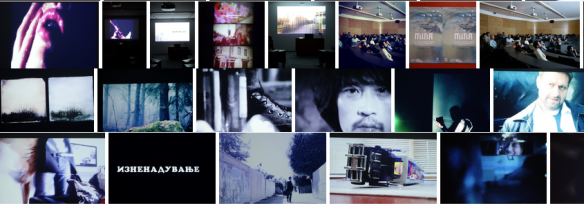WEEK TWO: Auckland (post 2 of 3): MINA 3rd International Mobile Innovation Screening 2013
As well as working with some of the ELVSS team on our Mobile Augmented Reality Film Workshops (more of that later), I’m in Auckland as a keynote speaker (along with Prof. Larissa Hjorth from RMIT) at the 3rd MINA Mobile Creativity and Mobile Innovation Symposium. I’m writing this after the event, which was so rich that I can’t fit everything into one post so I’ll write about the mobile film screenings here and the conference itself in a separate post.
SO, the films: The Symposium itself launched on Wednesday night with the first of three nightly screenings of mobile shorts from around the world. Each screening was held in a darkened theatre with films shown on a large screen. I’ve rarely viewed mobile films in this way before (having generally viewed films on smaller screens/devices – apart from when showing films to students, but then as standalone pieces rather than as a running showreel) and I was struck by the intensity of the experience. Because the films were so short, ranging from something like 15 seconds up to 3 minutes, we were immersed in mobile film in all it’s glory – a real cornucopia of genres, styles and aesthetics which showcased the rich possibilities of pocket cinema brilliantly. I’m more in love with mobile film than ever after this…
The depth and power of emotion in many of the short pieces is quite remarkable. These filmmakers really understand the medium and the art of telling a short story quickly. Interestingly, some of the films were virtually indistinguishable from big budget counterparts in terms of production values as a result of technological shifts (HD camphones) and were not only crisp and clear but also incredibly cinematic due to their framing and sweeping shots (for instance, Wilhelm Jerusalem – Kołacze by Lukasz Krysiewicz). Others retained a more lo-fi aesthetic, including several made using apps such as Instagram and Hipstamatic. Max Schleser’s film “Midtown” was filmed on an iPhone 4 with mCAMLITE, the mobile video created with the Time Piles app, edited with the Splice app and the music was produced using the iMaschine app. It’s amazing to think what can be created with the devices in our pockets.
As is practically a defining characteristic of ‘pocket cinema’, the films had a sense of immediacy, intimacy and authenticity. Personal devices are ideally suited for telling personal stories, and the films were so imaginative and varied – the one unifying feature being that they all proved how compelling short-form content can be when the idea/story is really strong. It doesn’t have to take a long time to take people on an emotional journey, as proved by films such as “A Grand Mother” by Candy Elsmore, which conveyed her delight and pride knowing that her grandmother had signed New Zealand’s Suffragette Petition over 100 years ago. The spark and wit of pieces such as Kevin Logan’s “To Have and To Have Not”, and Paul Taylor’s “Digital Trust Hike” were palpable, without detracting from deeper messages. I won’t list all of the films here, but I’ll be searching them out online and if available, will write a follow-up post listing the contributions with hyperlinks (many are not in the public realm as this may compromise their eligibility for festivals etc.).
The final night (Friday) was a showcase of films from other/partner mobile festivals, including SEISFF (Korean Mobile Film Festival), the Cinephone Spanish Mobile Film Festival, the Macedonia Mobile Film Festival, the USA Mobile Film Festival, and the Ohrenblick and Mobile Streifen Festivals (Germany).
There’s something about sitting in a darkened room watching a succession of short-form films on a big screen. It’s intense, compelling, leading the viewer into a Zen-like state. It had me thinking about the Netflix model of releasing an entire series in one go (see Kevin Spacey’s speech here). Increasingly, audiences want to be immersed in a viewing experience, and in the digital age, we can be. However, this isn’t just about gorging on the latest epic (obvious examples being The Wire, Breaking Bad, Game of Thrones, Orange is the New Black – even though 3 of these were broadcast as regular series, many or even most viewers saved themselves so they could watch the entire thing over a short space of time). In the case of the MINA 2013 screenings, we experienced the depth and immersion in a much shorter time period, ideally suited to short form content.
As you can tell, the MINA screenings were truly inspiring. They made me want to go away and start creating there and then – and judging by the conversations I was having many others felt the same. These screenings were invaluable in terms of opening the mind to what’s possible – vertical and square formats, durations as short as 15 seconds, a huge variety of styles and genres – it’s a brilliant exercise in freeing the mind from the constraints of industry-led convention. I’m looking forward to showing the MINA 2013 DVD to my students next semester as I think it’s a powerful way to experience mobile film, and I hope that it will really open up their minds and get them thinking about what’s possible, pushing them to create in new ways.
Here’s the MINA 2013 Showreel as a taster – and some stills here.
Some more of the films:
- The Girl with The Red Balloons: Nathalie Giraud + Timothee Corteggiani
- Break: Benoit Labourdette
- Sliver of Necessity: Marsha Berry
- Sincerely Yours: Anders Weberg
- North – A Korsakow/Instagram film by Patrick Kelly (interactive)


Pingback: Auckland: Mobile and Augmented Reality Film Workshops/Journalism Symposium | Heloukee: EdTech and Digital Culture